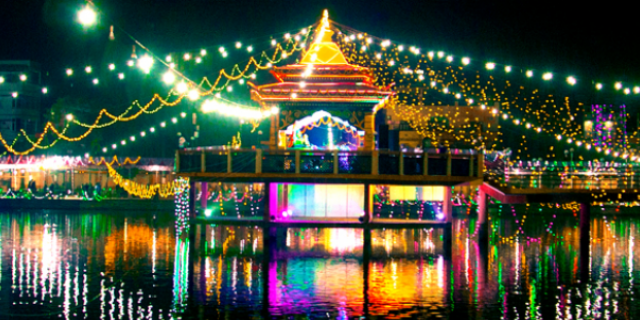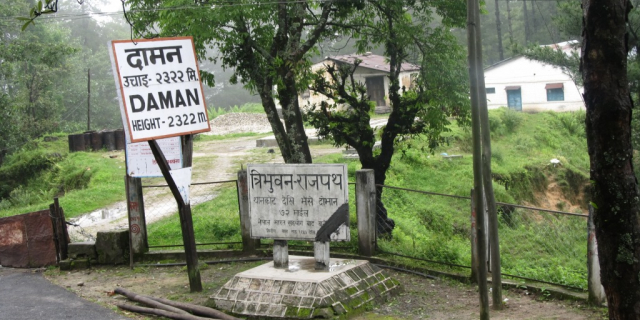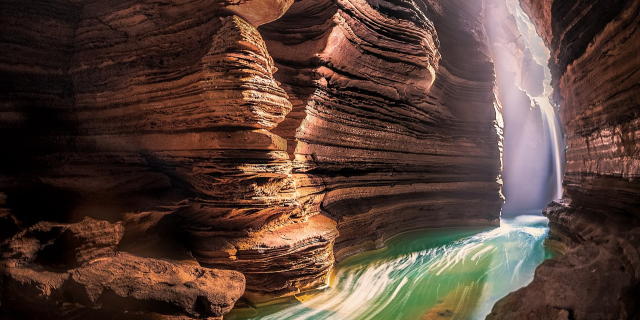Kushinagar (Pali: Kusinārā; Sanskrit: Kuśinagara) is a town in the Kushinagar district in Uttar Pradesh, India. Located 53 kilometres (33 miles) east of Gorakhpur on National Highway 27, Kushinagar is an important and popular Buddhist pilgrimage site, where Buddhists believe Gautama Buddha attained parinirvana.
The present Kushinagar is identified with Kusavati (in the pre-Buddha period) and Kushinara (in the post-Buddha period). It was the capital of one of the two Malla republics. The two Malla republics comprised one of the sixteen mahajanpads (oligarchic republics) of India in the 6th century BCE. Since then, it remained an integral part of the erstwhile empires of Maurya, Shunga, Kushana, Gupta, Harsha, and Pala dynasties.[citation needed]
Location of Gautama Buddha's death and parinirvanaWhen the Buddha reached his eightieth year, he felt that his time in this world was approaching an end. At that time, according to the Mahāparinibbāṇa Sutta (Sutta 16 of the Dīgha Nikāya), he and some of his disciples undertook a months-long journey that would take them from Rājagṛha, through Pāṭaliputta, Vesāli, Bhoganagara, and Pāvā, to their final destination at Kushinagar.[1] It was at Pāvā that Cunda, a resident of Pāvā, invited the group to a meal that featured a food called sukaramaddava. This would prove to be the Buddha's last meal, as he was afflicted by a painful illness resembling dysentery soon after consuming the meal.[2] After the meal, the Buddha crossed the Kakkuttha River (now called the Khanua River) and completed his journey to Kushinagar.[3]
According to the Mahāparinibbāṇa Sutta, the Buddha attained parinirvana shortly after his arrival in Kushinagar. Seven days after his parinirvana, the remains of the Buddha were cremated at that location. Originally his ashes were to go only to the Sakya clan, to which the Buddha belonged. However, six other clans and a king demanded the ashes of the Buddha. In order to resolve this dispute, a Brahmin named Drona divided the ashes of the Buddha into eight portions. These portions were distributed as follows: to Ajātasattu, king of Magadha; to the Licchavis of Vesāli; to the Sakyas of Kapilavastu; to the Bulis of Allakappa; to the Koliyas of Rāmagāma; to the brahmin of Veṭhadīpa; to the Mallas of Pāvā; and to the Mallas of Kushinagar.[4] In addition to these eight portions, two other important relics were distributed at that time: Drona (the brahmin who distributed the relics) received the vessel in which the body had been cremated, and the Moriyas of Pipphalivana received the remaining ashes of the funeral pyre.[4][5] According to Buddhaghosa, Each of these ten portions was placed in a reliquary (such as the Kanishka casket or the Bimaran casket) and buried in a tumulus.[5] These tumuli have been expanded or reconstructed over many centuries to form large stupas. Of these, the only one which remains intact is the Ramagrama stupa in Ramgram, Nepal.
5th century CE - 18th century CEDuring the medieval period, Kushinagar was under the suzerainty of Kalachuri kings.[citation needed] The city was largely abandoned after the Islamic invasions of the 12th century, although the region was ruled over by a Rajput king named Madan Singh in the 15th century.[citation needed]
19th centuryThe earliest mention of the ruins at Kushinagar in modern literature was in 1837, by D. Liston. Liston noted that it was "an object of worship" and pilgrimage site, but misunderstood the ruins to be the remnants of the fortress of a powerful divinity by the name of Mata Koonr.[6]
Kushinagar came back into prominence when Alexander Cunningham performed archaeological excavations at Matha Kuar shrine and Ramabhar stupa in 1861-1862. Cunningham was the first archaeologist to identify the ruins as being the site of the parinirvana of the Buddha.[7] Archibald Carlleyle exposed the Mahaparinirvana stupa and also discovered a 6.1 metres (20 feet) meters long reclining Buddha statue in 1876. In 1901, a Burmese monk named Sayadaw U Chandramani applied to the English Governor of India, seeking his permission to allow pilgrims to worship the reclining Buddha image in Kushinagar. Excavations continued in the early twentieth century under J. Ph. Vogel.[8] He conducted archaeological campaigns in 1904–1905, 1905-1906 and 1906–1907, uncovering a wealth of Buddhist materials.
In 1896, Laurence Waddell suggested that the site of the death and parinirvana of Gautama Buddha was in the region of Rampurva.[9] However, according to the Mahāparinibbāṇa Sutta, the Buddha made his journey to Kushinagar, where he walked into a grove of sala trees and laid himself to rest. There, he died and was cremated on the seventh day after his death. The accumulated body of archaeological evidence and the historical record both support the assertion that the Buddha died and was cremated in Kushinagar.[10][11][12][13][14]
Archaeological evidence from the 3rd century BCE suggests that Kushinagar was an ancient pilgrimage site.[15] For example, Ashoka built a stupa and placed a pillar to mark Buddha's attained parinirvana in Kushinagar.[16] The Hindu rulers of the Gupta Empire (fourth to seventh century) enlarged the stupa and constructed a temple containing a reclining Buddha statue.[17][18] This site was abandoned by Buddhist monks around 1200 CE, who fled to escape the invading Muslim army, after which the site decayed during the Islamic rule in India that followed.[19][20] British archaeologist Alexander Cunningham rediscovered Kushinagar in the late 19th century, and his colleague Archibald Carlleyle unearthed the 1,500-year-old reclining Buddha statue.[18][21][22] The site has since then become an important pilgrimage site for Buddhists.[15][23]
20th centuryAfter independence, Kushinagar remained a part of the district of Deoria. On 13 May 1994, it came into being as a new district of Uttar Pradesh.[24]


































Add new comment